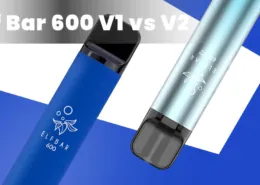What is the Difference Between Salt Nicotine and Regular Nicotine?
The vaping industry, a popular alternative to traditional smoking, is growing and evolving at an unprecedented rate. With this growth comes a range of products tailored to fit the unique needs and preferences of every individual. One of the most crucial elements in these products is nicotine, which can take various forms, each with its unique characteristics and impacts on the vaping experience. This comprehensive guide will delve into the specifics of “freebase nicotine” and “nicotine salts,” providing insights into their differences and implications for vapers.
The Nature of Nicotine
Nicotine is a naturally occurring alkaloid found in the tobacco plant. It’s a psychoactive substance responsible for the addictive quality of tobacco products. Over centuries, humans have used tobacco in various forms, but it’s most commonly associated with smoking cigarettes. Despite this association, nicotine exists in several forms, with each one influencing the body’s nicotine receptors differently.
The type of nicotine utilized in e-liquids – the liquids used in vaping devices – significantly impacts the overall vaping experience. Thus, it’s vital to understand the two primary types of nicotine prevalent in the vaping world: freebase nicotine and salt nicotine. Let’s delve into the properties and characteristics of these two forms of nicotine.
Read more:
Freebase Nicotine: The Traditional Route
Freebase nicotine represents the purest form of nicotine. It’s chemically modified to enhance its potency, leading to higher levels of addiction. This form of nicotine has been a staple in the tobacco industry since the 1960s, largely thanks to the efforts of Phillip Morris, Marlboro’s parent company.
The company manipulated the pH levels of nicotine to create a more potent ‘kick’ in their cigarettes, leading to higher bioavailability. This term refers to how efficiently a substance can be absorbed into the body. The increased alkalinity of freebase nicotine allows for rapid absorption and delivers a potent hit, much more so than other forms of nicotine.
However, freebase nicotine isn’t without its drawbacks. As the concentration of freebase nicotine increases, it can result in a harsh and sometimes uncomfortable throat hit. For many vapers, especially those new to the activity, this can be an unpleasant side effect. Additionally, the quick absorption rate of freebase nicotine can lead to a faster spike in nicotine blood levels, leading to a more intense but shorter-lasting nicotine rush.
Nicotine Salts: A Newer Trend
Nicotine salts represent a significant innovation in the vaping industry. Unlike their freebase counterparts, nicotine salts closely resemble the natural state of nicotine found in the tobacco leaf. In this form, nicotine has both positive and negative charges, classifying it as a ‘salt.’ However, this form of nicotine isn’t as efficiently absorbed in our bodies, leading to a less potent hit compared to freebase nicotine.
To combat this issue, manufacturers introduce an organic compound called benzoic acid into the mix. This acid serves to lower the pH of nicotine salts, reducing their overall alkalinity. This chemical reaction leads to a smoother throat hit, enabling users to enjoy higher concentrations of nicotine without experiencing discomfort.
This has made nicotine salts a favorite among heavy smokers transitioning to vaping. By providing a higher nicotine content without the harsh throat hit, nicotine salts offer a satisfying experience that closely mimics smoking a traditional cigarette. Moreover, the slower absorption rate of nicotine salts leads to a longer-lasting nicotine effect, providing a consistent experience for the user.
Read more:
Freebase Nicotine vs. Salt Nicotine
The core differences between freebase nicotine and salt nicotine lie in their pH levels, chemical structure, and the distinct vaping experiences they offer. Salt nicotine, characterized by its lower pH levels, results in a smoother vaping experience, even at higher concentrations. Conversely, freebase nicotine’s higher pH levels create a harsher throat hit, but deliver a more potent nicotine rush.
Your vaping device can also play a significant role in determining your choice between these two nicotine forms. For instance, high-powered devices that produce large amounts of vapor are usually better suited for freebase nicotine. These devices can effectively vaporize the nicotine, providing a rich, flavorful experience. On the other hand, low-power devices, often referred to as pod systems, are ideally suited for nicotine salts due to their efficiency at lower temperatures.
Guiding Your Vaping Choice
The choice between freebase nicotine and salt nicotine ultimately comes down to your personal needs and preferences. If you’re a heavy smoker transitioning to vaping, you might prefer the sensation offered by nicotine salts, which closely replicates that of traditional cigarettes. Conversely, if you’re a recreational vaper, who views vaping as a hobby rather than a substitute for smoking, you might prefer freebase nicotine. Its range of concentration levels offers more control over your nicotine intake, allowing you to taper down your usage as you see fit.
It’s also important to consider the device you’ll be using, as not all are compatible with both types of nicotine. High-powered devices, often used by experienced vapers, are typically used with freebase nicotine, while pod systems or low-power devices are typically paired with nicotine salts.
Beyond the type of nicotine and the device, personal taste and satisfaction also play a major role in your decision. Some people prefer the smoother hit of nicotine salts, while others enjoy the intense hit of freebase nicotine. It’s all about trying different options and seeing which one suits your preferences the best.
It’s important to remember that vaping, while generally considered less harmful than smoking, still carries potential health risks. Long-term effects of vaping are still being studied, and we don’t yet have a complete picture of its impact on our health. Therefore, regardless of your choice of nicotine, always prioritize your wellbeing. Consult with a healthcare professional if you’re considering significant changes to your nicotine consumption habits. And remember that while vaping can be a less harmful alternative, the best choice for your health is always to abstain from nicotine products altogether.
- Minneapolis Sets $25 Minimum Price for E-Cigarettes - July 11, 2025
- Alabama Schools to Implement New Anti-Vaping Policies - July 11, 2025
- Is Vaping and Driving Illegal in Rhode Island? (2025 Guide) - July 10, 2025









